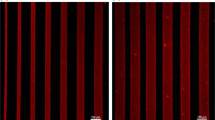Summary
In vitro characteristics of cardiac cells cultured in simulated microgravity are reported. Tissue culture methods performed at unit gravity constrain cells to propagate, differentiate, and interact in a two-dimensional (2D) plane. Neonatal rat cardiac cells in 2D culture organize predominantly as bundles of cardiomyocytes with the intervening areas filled by nonmyocyte cell types. Such cardiac cell cultures respond predictably to the addition of exogenous compounds, and in many ways they represent an excellent in vitro model system. The gravity-induced 2D organization of the cells, however, does not accurately reflect the distribution of cells in the intact tissue. We have begun characterizations of a three-dimensional (3D) culturing system designed to mimic microgravity. The NASA- designed High-Aspect Ratio Vessel (HARV) bioreactors provide a low shear environment that allows cells to be cultured in static suspension. HARV-3D cultures were prepared on microcarrier beads and compared to control-2D cultures using a combination of microscopic and biochemical techniques. Both systems were uniformly inoculated and medium exchanged at standard intervals. Cells in control cultures adhered to the polystyrene surface of the tissue culture dishes and exhibited typical 2D organization. Cells cultured in HARVs adhered to microcarrier beads, the beads aggregated into defined clusters containing 8 to 15 beads per cluster, and the clusters exhibited distinct 3D layers: myocytes and fibroblasts appeared attached to the surfaces of beads and were overlaid by an outer cell type. In addition, cultures prepared in HARVs using alternative support matrices also displayed morphological formations not seen in control cultures. Generally, the cells prepared in HARV and control cultures were similar; however, the dramatic alterations in 3D organization recommend the HARV as an ideal vessel for the generation of tissuelike organizations of cardiac cells in vitro.
Similar content being viewed by others
References
Balligand, J. L.; Kelly, R. A.; Marsden, P. A., et al. Control of cardiac muscle cell function by an endogenous nitric oxide signaling system. Proc. Natl. Acad. Sci. 90:347–351; 1993.
Cogoli, A. The effect of hypogravity and hypergravity on cells of the immune system. J. Leukocyte Biol. 54(3):259–268; 1993.
Cogoli, A.; Bechler, B.; Cogoli-Greuter, M., et al. J. Leukocyte. Biol. 53(5):569–575; 1993.
Freed, L. E.; Vunjak-Novakovic, G. Microgravity tissue engineering. In Vitro Cell. Dev. Biol. 33A:381–385, 1997.
Freerksen, D. L.; Schroedl, N. A.; Hartzell, C. R. Control of enzyme activity levels by serum and hydrocortisone in neonatal rat heart cells cultured in serum free medium. J. Cell. Physiol. 120:126–134; 1984.
Goldstein, M. A.; Edwards, R. J.; Schroeter, J. P. Cardiac morphology after conditions of microgravity during COSMOS 2044. J. Appl. Physiol. 73:94S-100S; 1992.
Gonda, S. R.; Goodwin, T.; Jessup, J. M., et al. NASA Technical Memorandum 100–473; p. 156; 1988.
Gonda, S. R.; Wolf, D. A.; Schwarz, R. P., et al. NASA Technical Memorandum 102–161; p. 33–34; 1989.
Goodwin T. J.; Prewett, T. L.; Wolf, D. A., et al. Reduced shear stress: a major component in the ability of mammalian tissues to form three-dimensional assemblies in simulated microgravity. J. Cell. Biochem. 51:301–311; 1993.
Holshek, J.; Akins, R. E. Acetonitrile is better than ethanol as a dehydrating agent for cells prepared for SEM. Proc. Microscop. Soc. Am. 52:324–325; 1994.
Mohamed, S.; Holmes, R.; Hartzell, C. R. A serum-free chemically-defined medium for function and growth of primary neonatal rat heart cell cultures. In Vitro Cell. Dev. Biol. 19:471–478; 1983.
Molnar, G.; Schroedl, N. A.; Gonda, S. R., et al. Skeletal muscle cells cultured in simulated microgravity. In Vitro Cell. Dev. Biol. 33A:386–391, 1997.
Morrison, D. R.; Chapes, S. K.; Guikema, J. A., et al. Experiments with suspended cells on the space shuttle. Physiologist 35:S31-S34; 1992.
Philpott, D. E.; Fine, A.; Kato, K., et al. Microgravity changes in heart structure and cAMP metabolism. Physiologist 28:S209; 1985.
Philpott, D. E.; Popova, I. A.; Kato, K., et al. Morphological and biochemical examination of COSMOS 1887 rat heart tissue. Part I. Ultrastructure. FASEB J. 4:73–78; 1990.
Prisk, G. K.; Guy, H. J.; Elliott, A. R., et al. Pulmonary diffusing capacity, capillary blood volume, and cardiac output during sustained microgravity. J. Appl. Physiol. 75(10):15–26; 1993.
Sadoshima, J. I.; Lothar, J.; Takahashi, T., et al. Molecular characterization of the stretch-induced adaptation of cultured cardiac cells. J. Biol. Chem. 267:10551–10560; 1992.
Schroedl, N. A.; Hartzell, C. R. Myocytes and fibroblasts exhibit functional synergism in mixed cultures of neonatal rat heart cells. J. Cell. Physiol. 117:326–332; 1983.
Schroedl, N.; Hartzell, C.; Ross, P., et al. Glucose metabolism, insulin effects, and developmental age of cultured neonatal rat heart cells. J. Cell. Physiol. 113:231–239; 1982.
Tairbekov, M. G. Cells in gravitational fields. Physiologist 35:S16-S19; 1992.
Thomason, D. B.; Morrison, P. R.; Oganov, V., et al. Altered actin and myosin expression in muscle during exposure to microgravity. J. Appl. Physiol. 73:90S-93S; 1992.
Vandenburgh, H. H. Mechanical forces and their second messengers in stimulating cell growth in vitro. Am. J. Physiol. 262:R350-R355; 1992.
Author information
Authors and Affiliations
Rights and permissions
About this article
Cite this article
Akins, R.E., Schroedl, N.A., Gonda, S.R. et al. Neonatal rat heart cells cultured in simulated microgravity. In Vitro Cell.Dev.Biol.-Animal 33, 337–343 (1997). https://doi.org/10.1007/s11626-997-0003-8
Issue Date:
DOI: https://doi.org/10.1007/s11626-997-0003-8




